AFIN352 - Applied Portfolio Management Project Report, Macquarie Uni.
VerifiedAdded on 2023/06/11
|11
|1167
|54
Report
AI Summary
This report provides an overview of applied portfolio management, focusing on essential processes and the increasing importance of portfolio management today. It establishes portfolio standards, including time and budget allocation, and defines a strategic portfolio based on selected criteria. The report evaluates portfolio performance through scenario planning and suggests improvements based on demand analysis and time management. It critiques the Markowitz model and measures the portfolio using the single index model, highlighting the differences between these models and their impact on portfolio performance. Effective project delivery and adaptability are emphasized for improving portfolio performance, along with the importance of re-evaluating project value, risk, and cost. The report also touches upon the significance of timely information from project management, resource management, and financial management processes for effective portfolio decisions. References to various studies and handbooks are included to support the analysis.
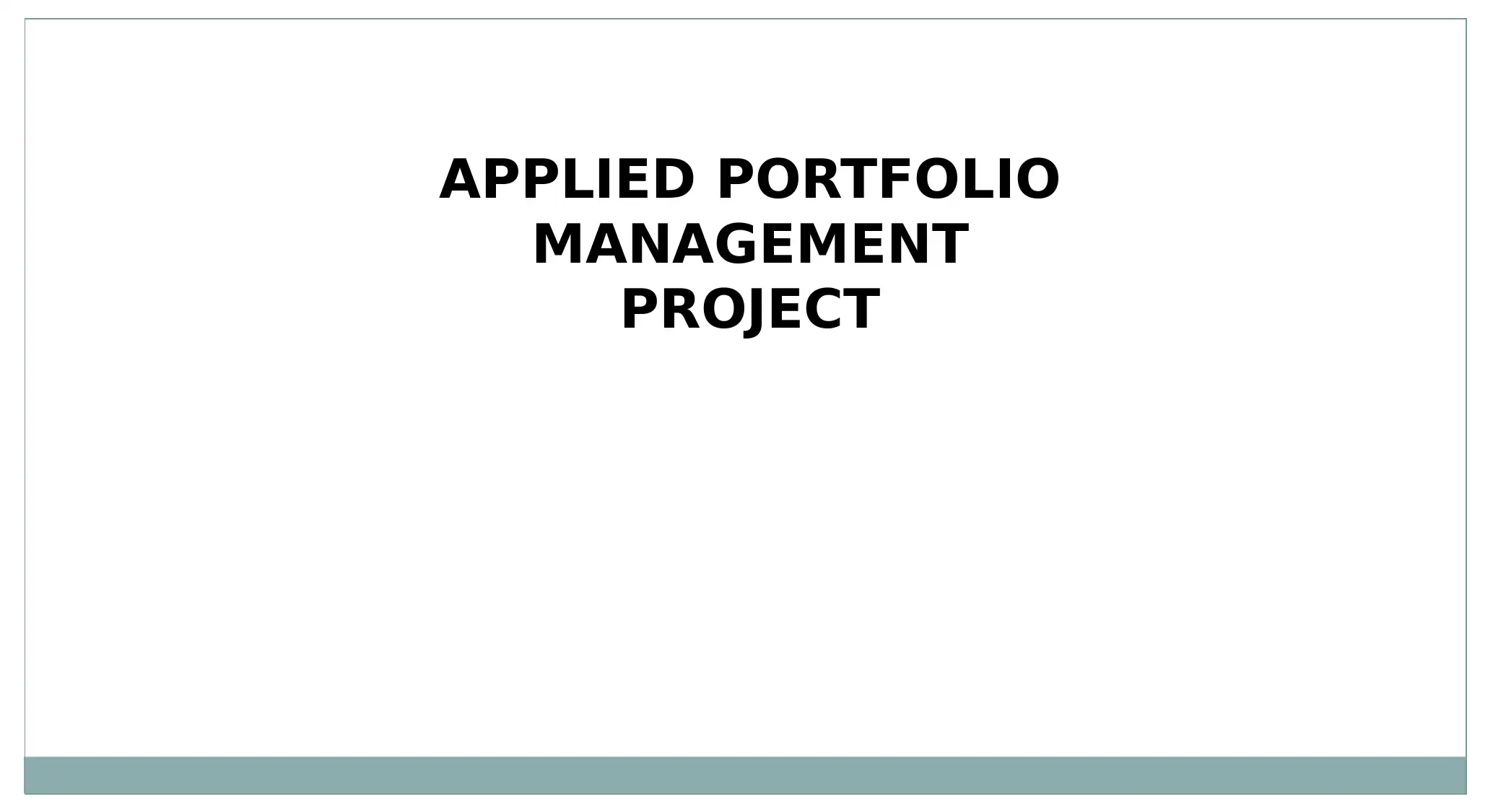
APPLIED PORTFOLIO
MANAGEMENT
PROJECT
MANAGEMENT
PROJECT
Paraphrase This Document
Need a fresh take? Get an instant paraphrase of this document with our AI Paraphraser
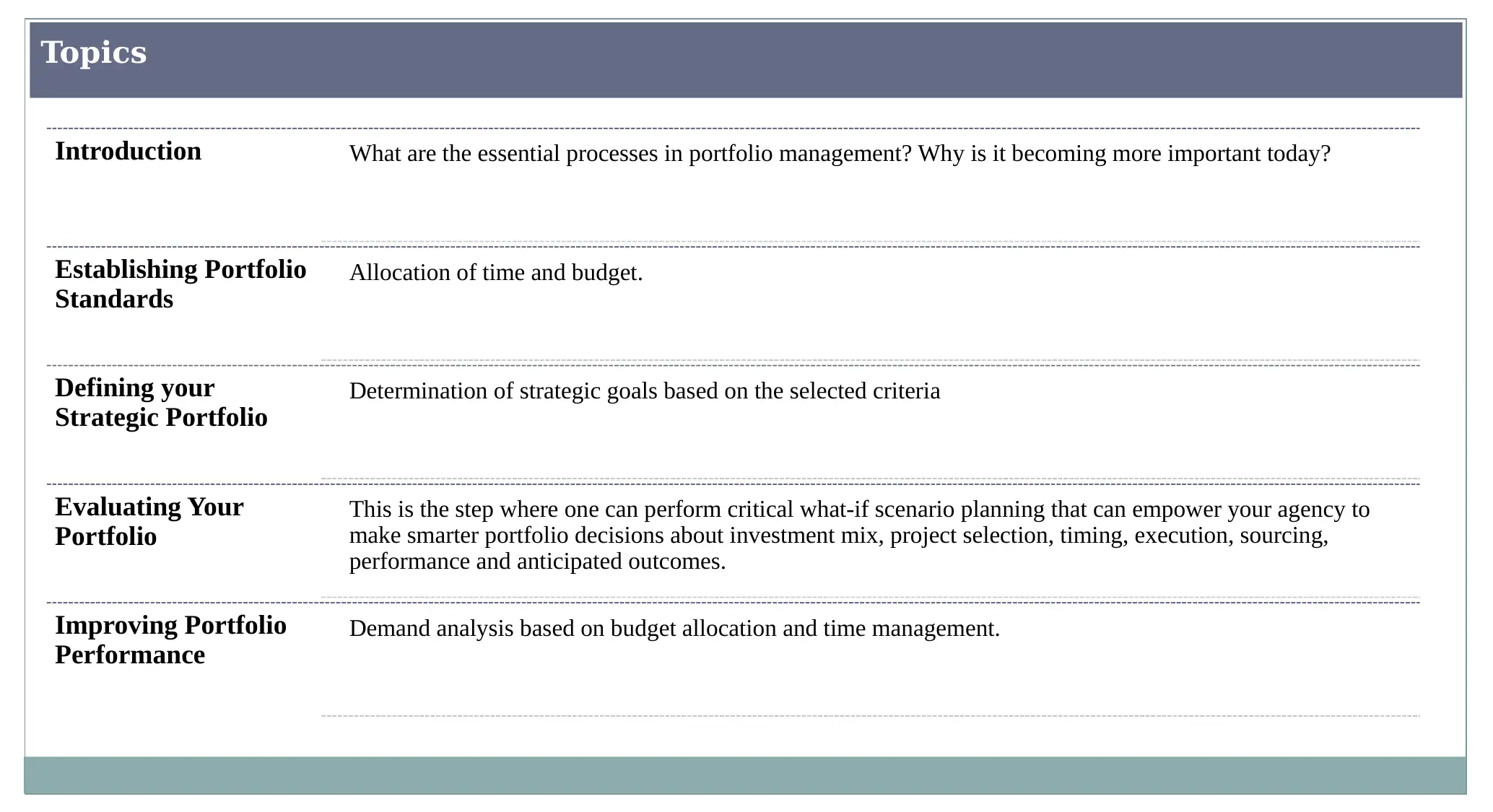
Introduction What are the essential processes in portfolio management? Why is it becoming more important today?
Establishing Portfolio
Standards
Allocation of time and budget.
Defining your
Strategic Portfolio
Determination of strategic goals based on the selected criteria
Evaluating Your
Portfolio
This is the step where one can perform critical what-if scenario planning that can empower your agency to
make smarter portfolio decisions about investment mix, project selection, timing, execution, sourcing,
performance and anticipated outcomes.
Improving Portfolio
Performance
Demand analysis based on budget allocation and time management.
Topics
Establishing Portfolio
Standards
Allocation of time and budget.
Defining your
Strategic Portfolio
Determination of strategic goals based on the selected criteria
Evaluating Your
Portfolio
This is the step where one can perform critical what-if scenario planning that can empower your agency to
make smarter portfolio decisions about investment mix, project selection, timing, execution, sourcing,
performance and anticipated outcomes.
Improving Portfolio
Performance
Demand analysis based on budget allocation and time management.
Topics
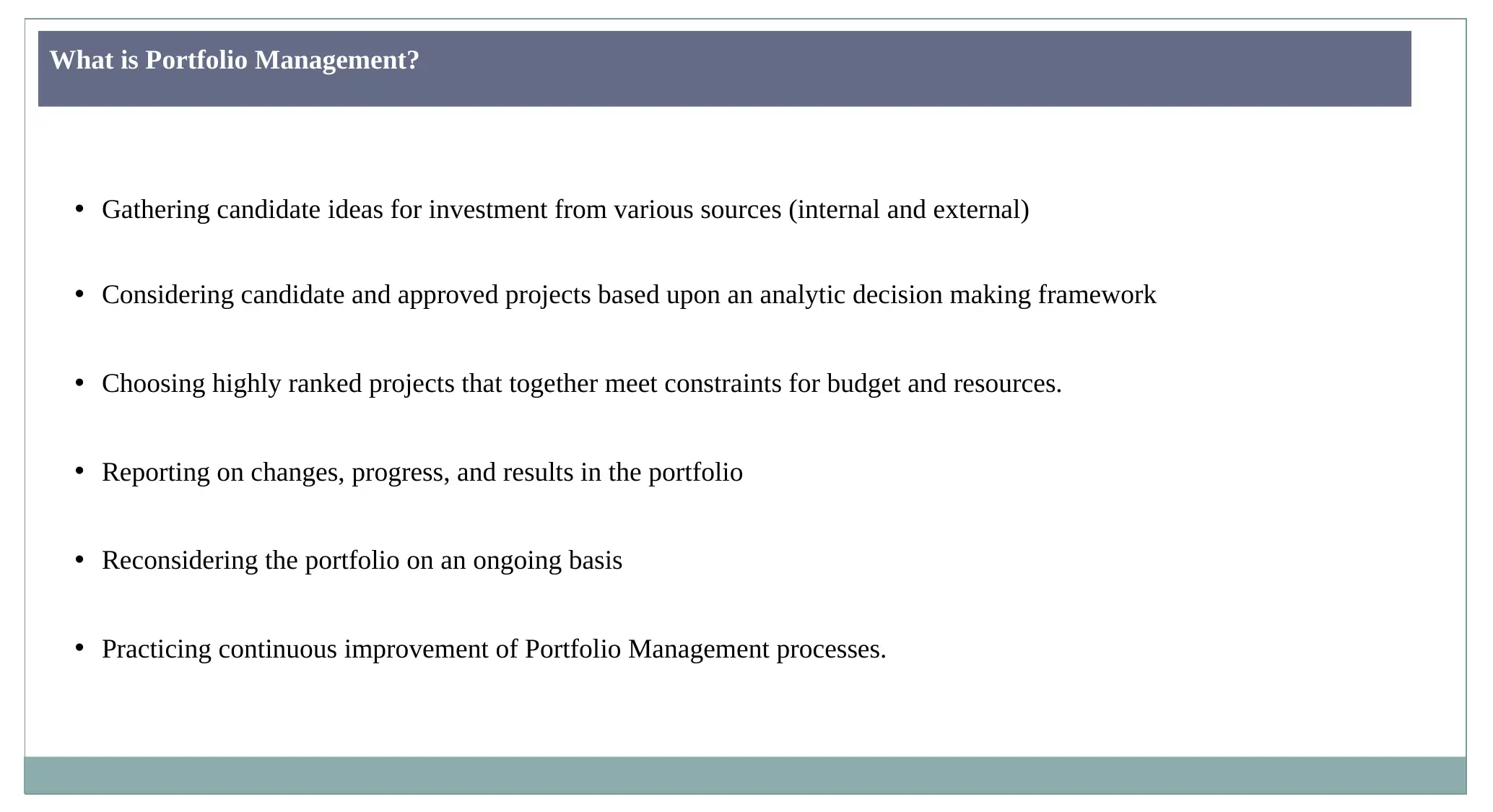
• Gathering candidate ideas for investment from various sources (internal and external)
• Considering candidate and approved projects based upon an analytic decision making framework
• Choosing highly ranked projects that together meet constraints for budget and resources.
• Reporting on changes, progress, and results in the portfolio
• Reconsidering the portfolio on an ongoing basis
• Practicing continuous improvement of Portfolio Management processes.
What is Portfolio Management?
• Considering candidate and approved projects based upon an analytic decision making framework
• Choosing highly ranked projects that together meet constraints for budget and resources.
• Reporting on changes, progress, and results in the portfolio
• Reconsidering the portfolio on an ongoing basis
• Practicing continuous improvement of Portfolio Management processes.
What is Portfolio Management?
⊘ This is a preview!⊘
Do you want full access?
Subscribe today to unlock all pages.

Trusted by 1+ million students worldwide
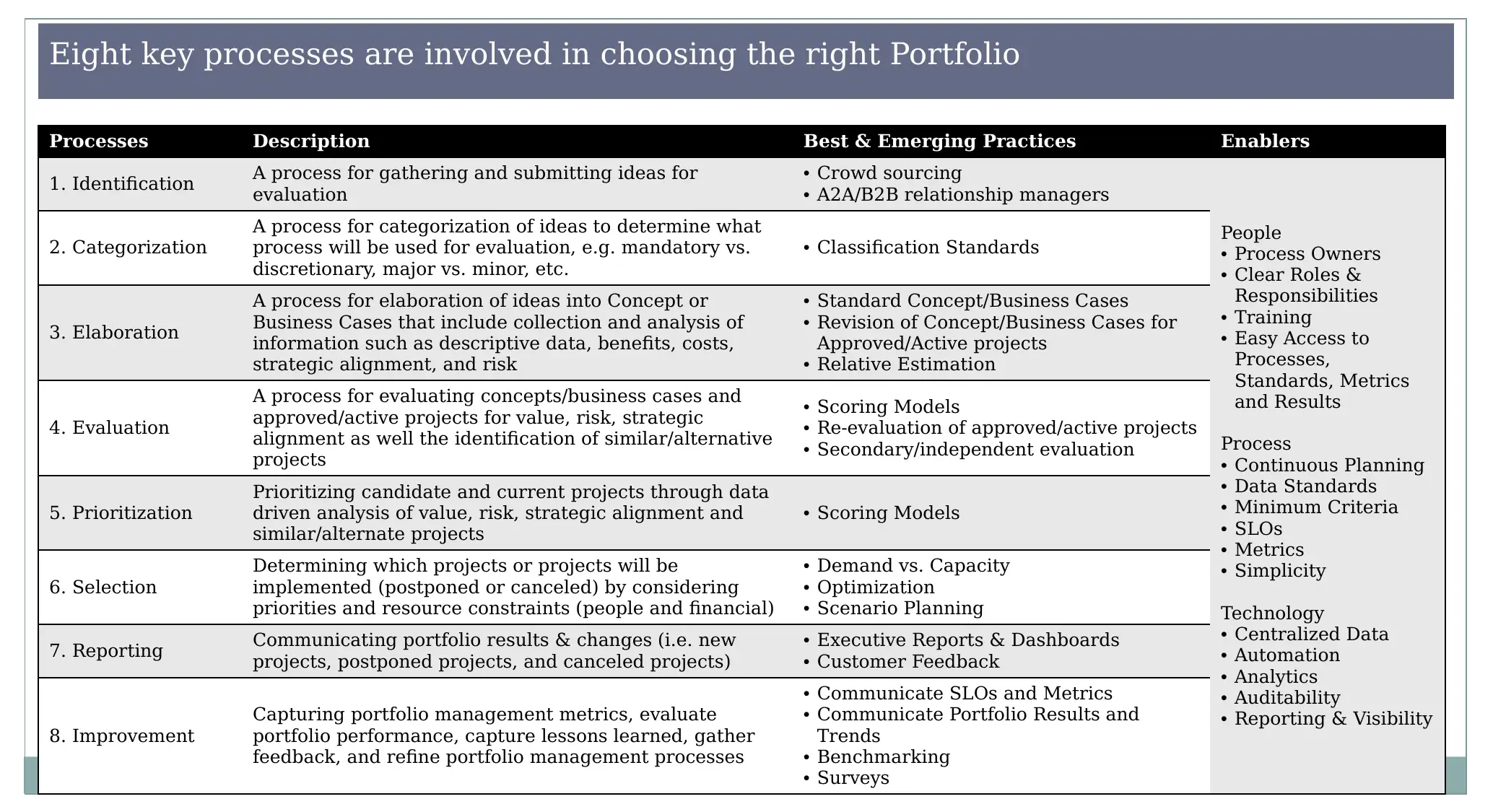
Eight key processes are involved in choosing the right Portfolio
Processes Description Best & Emerging Practices Enablers
1. Identification A process for gathering and submitting ideas for
evaluation
• Crowd sourcing
• A2A/B2B relationship managers
People
• Process Owners
• Clear Roles &
Responsibilities
• Training
• Easy Access to
Processes,
Standards, Metrics
and Results
Process
• Continuous Planning
• Data Standards
• Minimum Criteria
• SLOs
• Metrics
• Simplicity
Technology
• Centralized Data
• Automation
• Analytics
• Auditability
• Reporting & Visibility
2. Categorization
A process for categorization of ideas to determine what
process will be used for evaluation, e.g. mandatory vs.
discretionary, major vs. minor, etc.
• Classification Standards
3. Elaboration
A process for elaboration of ideas into Concept or
Business Cases that include collection and analysis of
information such as descriptive data, benefits, costs,
strategic alignment, and risk
• Standard Concept/Business Cases
• Revision of Concept/Business Cases for
Approved/Active projects
• Relative Estimation
4. Evaluation
A process for evaluating concepts/business cases and
approved/active projects for value, risk, strategic
alignment as well the identification of similar/alternative
projects
• Scoring Models
• Re-evaluation of approved/active projects
• Secondary/independent evaluation
5. Prioritization
Prioritizing candidate and current projects through data
driven analysis of value, risk, strategic alignment and
similar/alternate projects
• Scoring Models
6. Selection
Determining which projects or projects will be
implemented (postponed or canceled) by considering
priorities and resource constraints (people and financial)
• Demand vs. Capacity
• Optimization
• Scenario Planning
7. Reporting Communicating portfolio results & changes (i.e. new
projects, postponed projects, and canceled projects)
• Executive Reports & Dashboards
• Customer Feedback
8. Improvement
Capturing portfolio management metrics, evaluate
portfolio performance, capture lessons learned, gather
feedback, and refine portfolio management processes
• Communicate SLOs and Metrics
• Communicate Portfolio Results and
Trends
• Benchmarking
• Surveys
Processes Description Best & Emerging Practices Enablers
1. Identification A process for gathering and submitting ideas for
evaluation
• Crowd sourcing
• A2A/B2B relationship managers
People
• Process Owners
• Clear Roles &
Responsibilities
• Training
• Easy Access to
Processes,
Standards, Metrics
and Results
Process
• Continuous Planning
• Data Standards
• Minimum Criteria
• SLOs
• Metrics
• Simplicity
Technology
• Centralized Data
• Automation
• Analytics
• Auditability
• Reporting & Visibility
2. Categorization
A process for categorization of ideas to determine what
process will be used for evaluation, e.g. mandatory vs.
discretionary, major vs. minor, etc.
• Classification Standards
3. Elaboration
A process for elaboration of ideas into Concept or
Business Cases that include collection and analysis of
information such as descriptive data, benefits, costs,
strategic alignment, and risk
• Standard Concept/Business Cases
• Revision of Concept/Business Cases for
Approved/Active projects
• Relative Estimation
4. Evaluation
A process for evaluating concepts/business cases and
approved/active projects for value, risk, strategic
alignment as well the identification of similar/alternative
projects
• Scoring Models
• Re-evaluation of approved/active projects
• Secondary/independent evaluation
5. Prioritization
Prioritizing candidate and current projects through data
driven analysis of value, risk, strategic alignment and
similar/alternate projects
• Scoring Models
6. Selection
Determining which projects or projects will be
implemented (postponed or canceled) by considering
priorities and resource constraints (people and financial)
• Demand vs. Capacity
• Optimization
• Scenario Planning
7. Reporting Communicating portfolio results & changes (i.e. new
projects, postponed projects, and canceled projects)
• Executive Reports & Dashboards
• Customer Feedback
8. Improvement
Capturing portfolio management metrics, evaluate
portfolio performance, capture lessons learned, gather
feedback, and refine portfolio management processes
• Communicate SLOs and Metrics
• Communicate Portfolio Results and
Trends
• Benchmarking
• Surveys
Paraphrase This Document
Need a fresh take? Get an instant paraphrase of this document with our AI Paraphraser
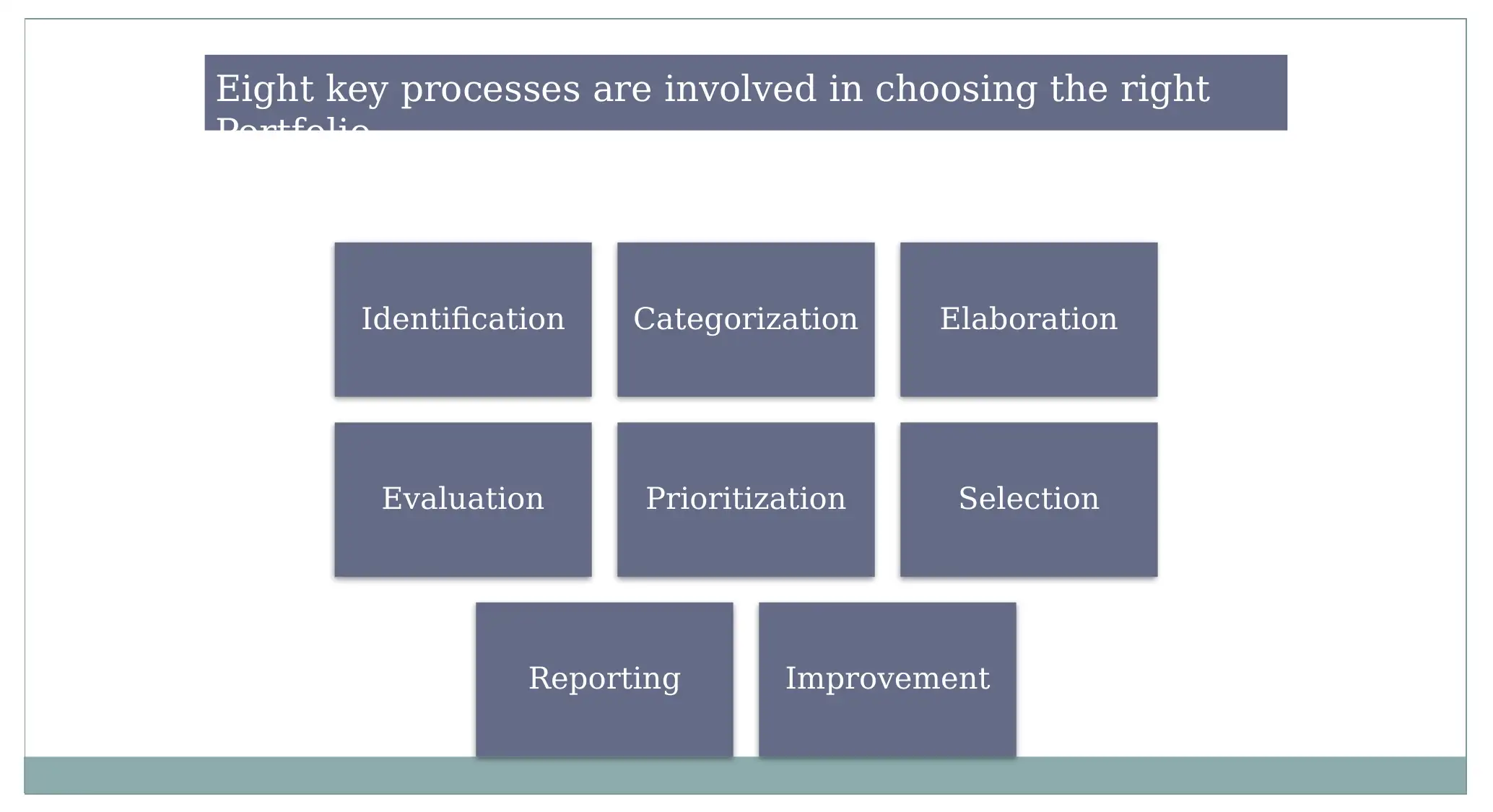
Identification Categorization Elaboration
Evaluation Prioritization Selection
Reporting Improvement
Eight key processes are involved in choosing the right
Portfolio
Evaluation Prioritization Selection
Reporting Improvement
Eight key processes are involved in choosing the right
Portfolio
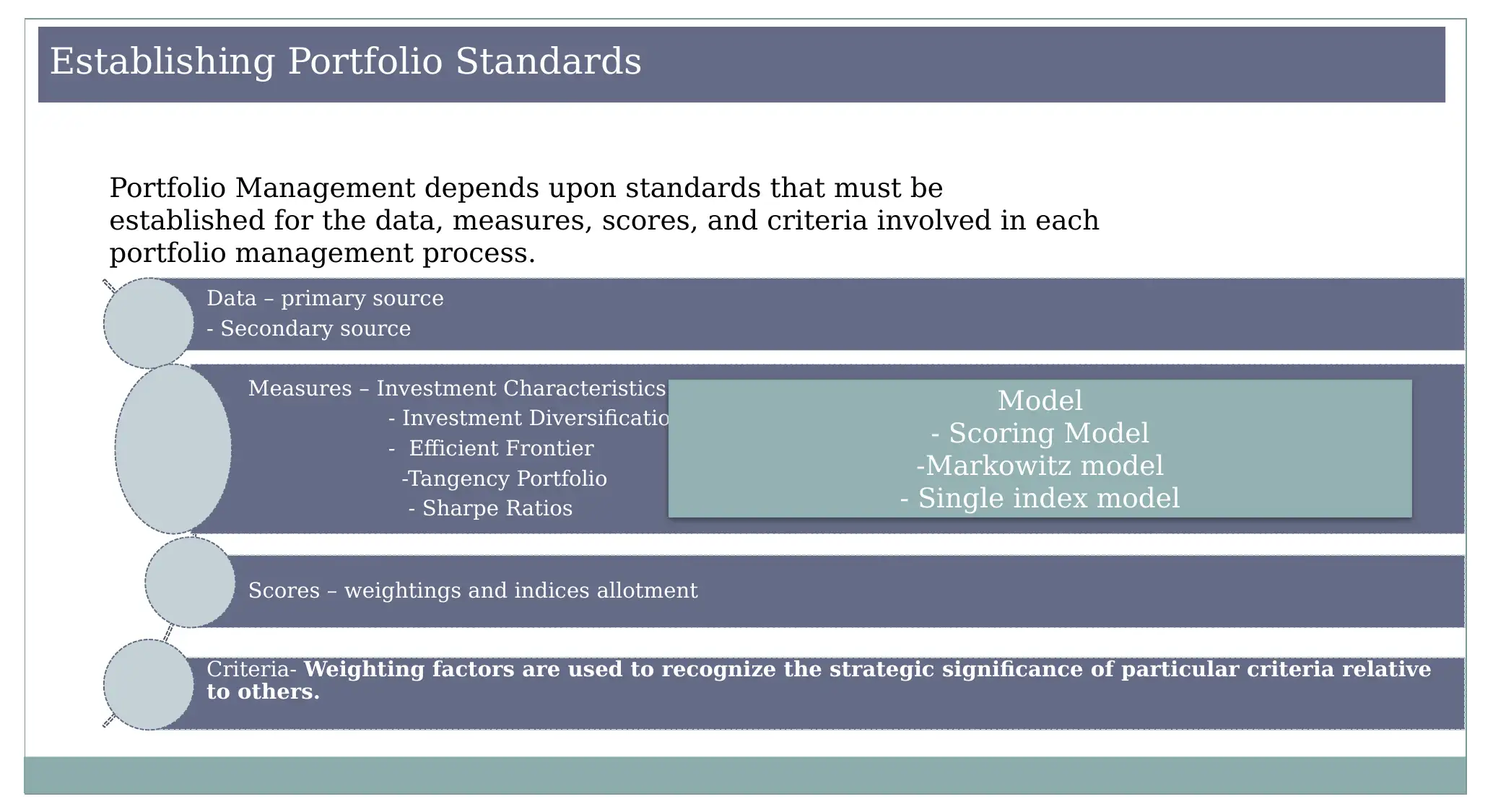
Establishing Portfolio Standards
Portfolio Management depends upon standards that must be
established for the data, measures, scores, and criteria involved in each
portfolio management process.
Data – primary source
- Secondary source
Measures – Investment Characteristics
- Investment Diversification
- Efficient Frontier
-Tangency Portfolio
- Sharpe Ratios
Scores – weightings and indices allotment
Criteria- Weighting factors are used to recognize the strategic significance of particular criteria relative
to others.
Model
- Scoring Model
-Markowitz model
- Single index model
Portfolio Management depends upon standards that must be
established for the data, measures, scores, and criteria involved in each
portfolio management process.
Data – primary source
- Secondary source
Measures – Investment Characteristics
- Investment Diversification
- Efficient Frontier
-Tangency Portfolio
- Sharpe Ratios
Scores – weightings and indices allotment
Criteria- Weighting factors are used to recognize the strategic significance of particular criteria relative
to others.
Model
- Scoring Model
-Markowitz model
- Single index model
⊘ This is a preview!⊘
Do you want full access?
Subscribe today to unlock all pages.

Trusted by 1+ million students worldwide
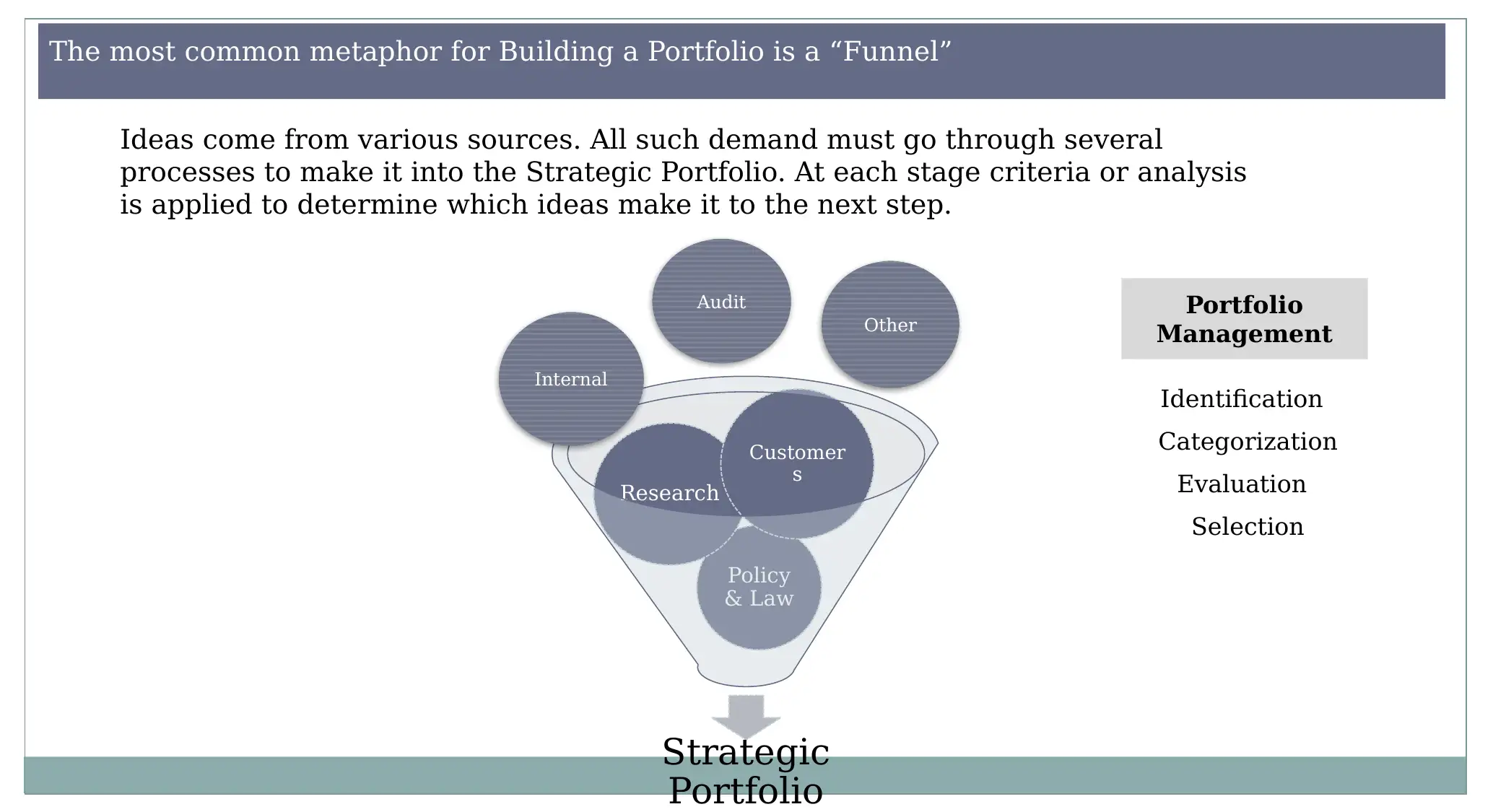
Strategic
Portfolio
Policy
& Law
Research
Customer
s
The most common metaphor for Building a Portfolio is a “Funnel”
Internal
Audit
Other
Ideas come from various sources. All such demand must go through several
processes to make it into the Strategic Portfolio. At each stage criteria or analysis
is applied to determine which ideas make it to the next step.
Portfolio
Management
Identification
Categorization
Evaluation
Selection
Portfolio
Policy
& Law
Research
Customer
s
The most common metaphor for Building a Portfolio is a “Funnel”
Internal
Audit
Other
Ideas come from various sources. All such demand must go through several
processes to make it into the Strategic Portfolio. At each stage criteria or analysis
is applied to determine which ideas make it to the next step.
Portfolio
Management
Identification
Categorization
Evaluation
Selection
Paraphrase This Document
Need a fresh take? Get an instant paraphrase of this document with our AI Paraphraser
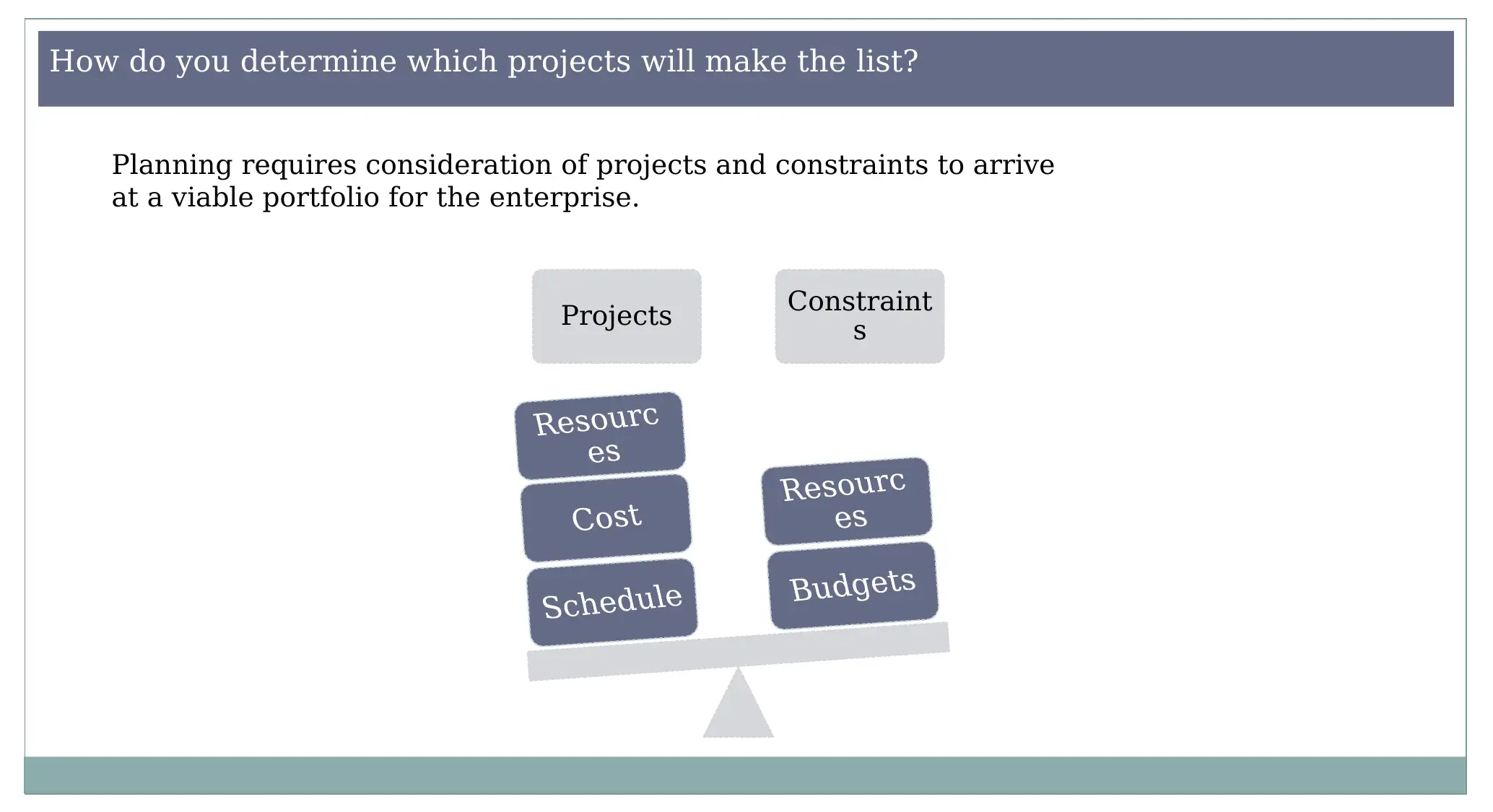
Projects Constraint
s
How do you determine which projects will make the list?
Planning requires consideration of projects and constraints to arrive
at a viable portfolio for the enterprise.
s
How do you determine which projects will make the list?
Planning requires consideration of projects and constraints to arrive
at a viable portfolio for the enterprise.
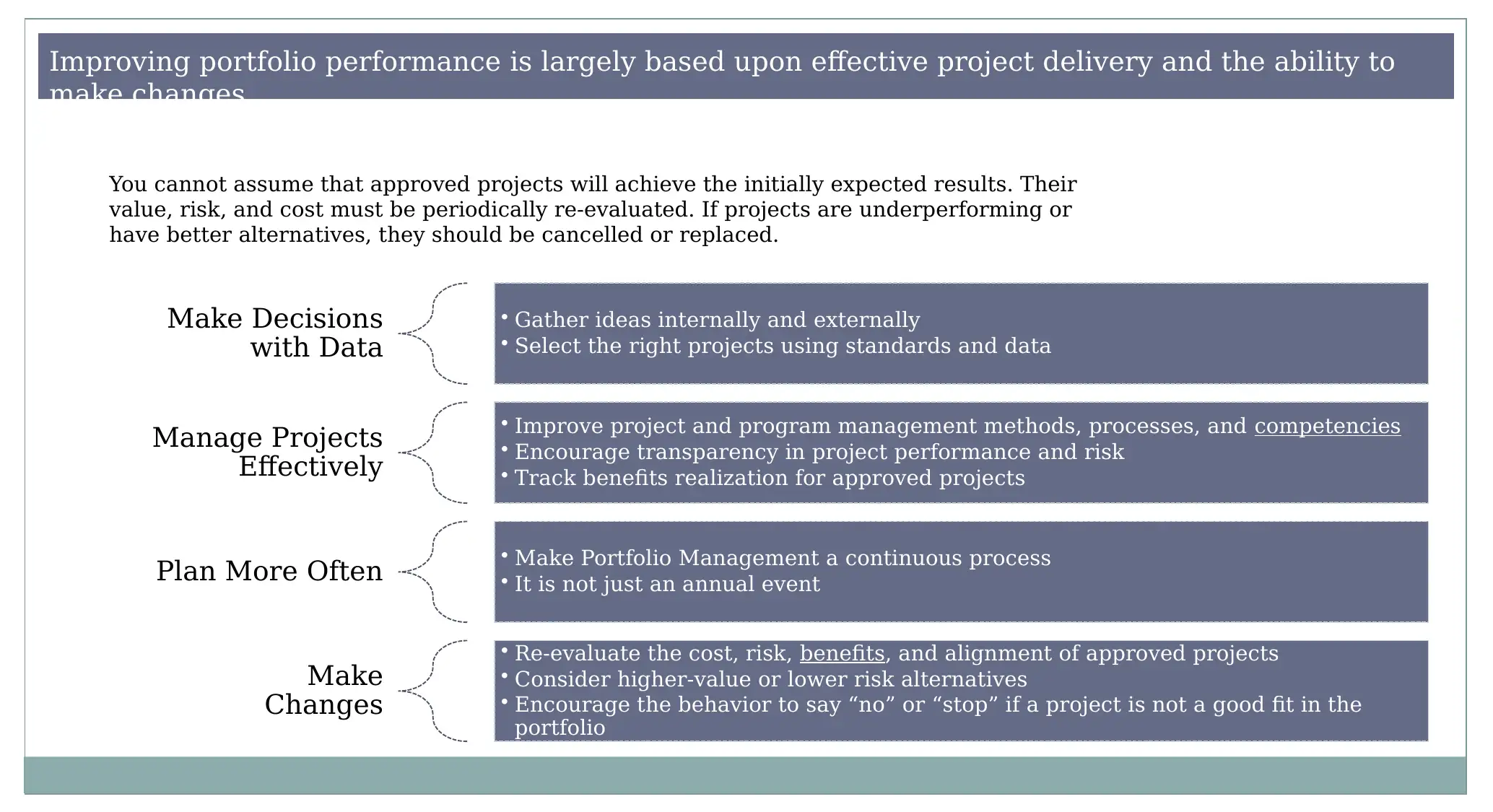
Make Decisions
with Data
• Gather ideas internally and externally
• Select the right projects using standards and data
Manage Projects
Effectively
• Improve project and program management methods, processes, and competencies
• Encourage transparency in project performance and risk
• Track benefits realization for approved projects
Plan More Often • Make Portfolio Management a continuous process
• It is not just an annual event
Make
Changes
• Re-evaluate the cost, risk, benefits, and alignment of approved projects
• Consider higher-value or lower risk alternatives
• Encourage the behavior to say “no” or “stop” if a project is not a good fit in the
portfolio
Improving portfolio performance is largely based upon effective project delivery and the ability to
make changes
You cannot assume that approved projects will achieve the initially expected results. Their
value, risk, and cost must be periodically re-evaluated. If projects are underperforming or
have better alternatives, they should be cancelled or replaced.
with Data
• Gather ideas internally and externally
• Select the right projects using standards and data
Manage Projects
Effectively
• Improve project and program management methods, processes, and competencies
• Encourage transparency in project performance and risk
• Track benefits realization for approved projects
Plan More Often • Make Portfolio Management a continuous process
• It is not just an annual event
Make
Changes
• Re-evaluate the cost, risk, benefits, and alignment of approved projects
• Consider higher-value or lower risk alternatives
• Encourage the behavior to say “no” or “stop” if a project is not a good fit in the
portfolio
Improving portfolio performance is largely based upon effective project delivery and the ability to
make changes
You cannot assume that approved projects will achieve the initially expected results. Their
value, risk, and cost must be periodically re-evaluated. If projects are underperforming or
have better alternatives, they should be cancelled or replaced.
⊘ This is a preview!⊘
Do you want full access?
Subscribe today to unlock all pages.

Trusted by 1+ million students worldwide
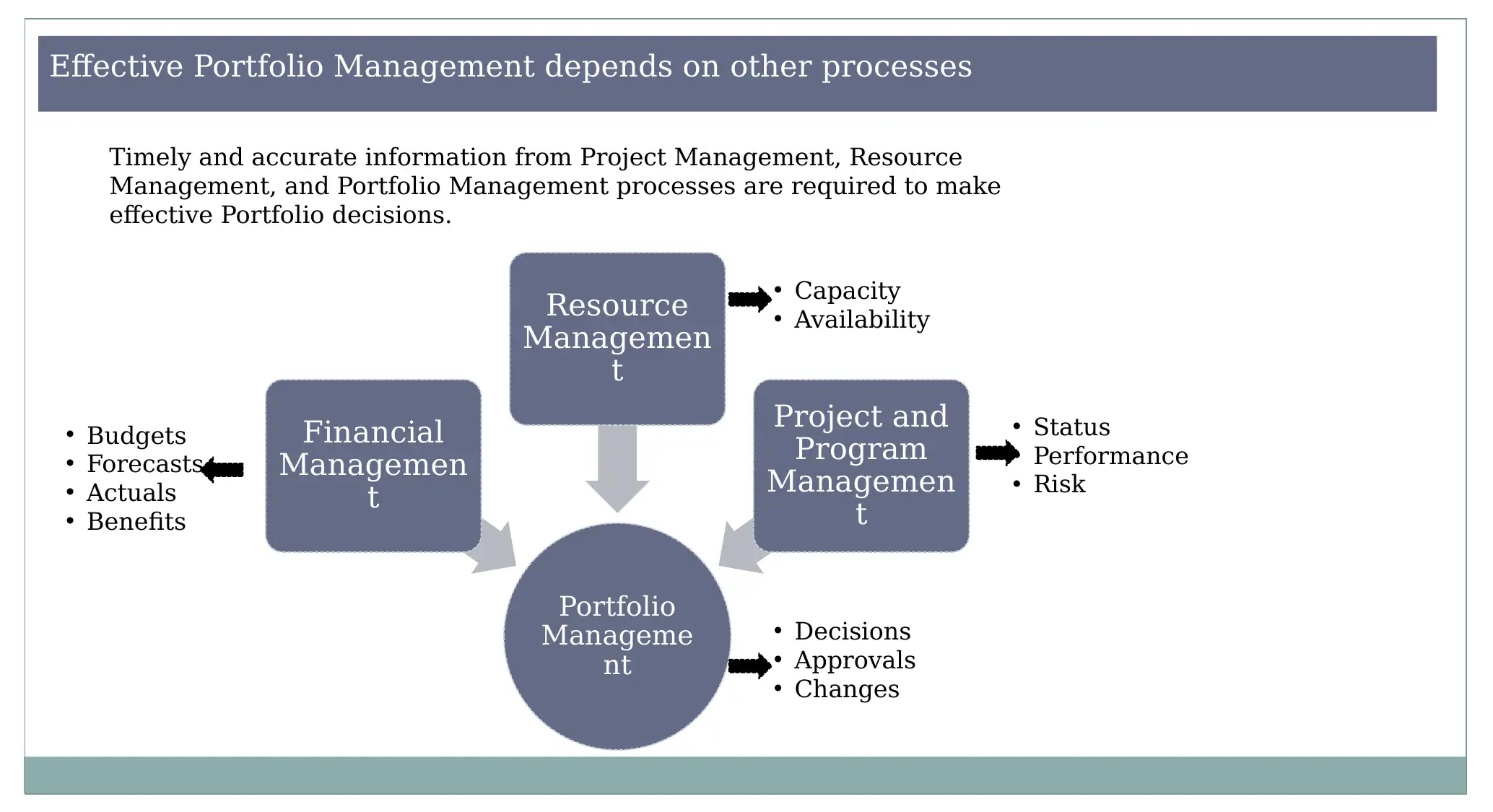
Portfolio
Manageme
nt
Financial
Managemen
t
Resource
Managemen
t
Project and
Program
Managemen
t
Effective Portfolio Management depends on other processes
Timely and accurate information from Project Management, Resource
Management, and Portfolio Management processes are required to make
effective Portfolio decisions.
• Status
• Performance
• Risk
• Capacity
• Availability
• Budgets
• Forecasts
• Actuals
• Benefits
• Decisions
• Approvals
• Changes
Manageme
nt
Financial
Managemen
t
Resource
Managemen
t
Project and
Program
Managemen
t
Effective Portfolio Management depends on other processes
Timely and accurate information from Project Management, Resource
Management, and Portfolio Management processes are required to make
effective Portfolio decisions.
• Status
• Performance
• Risk
• Capacity
• Availability
• Budgets
• Forecasts
• Actuals
• Benefits
• Decisions
• Approvals
• Changes
Paraphrase This Document
Need a fresh take? Get an instant paraphrase of this document with our AI Paraphraser
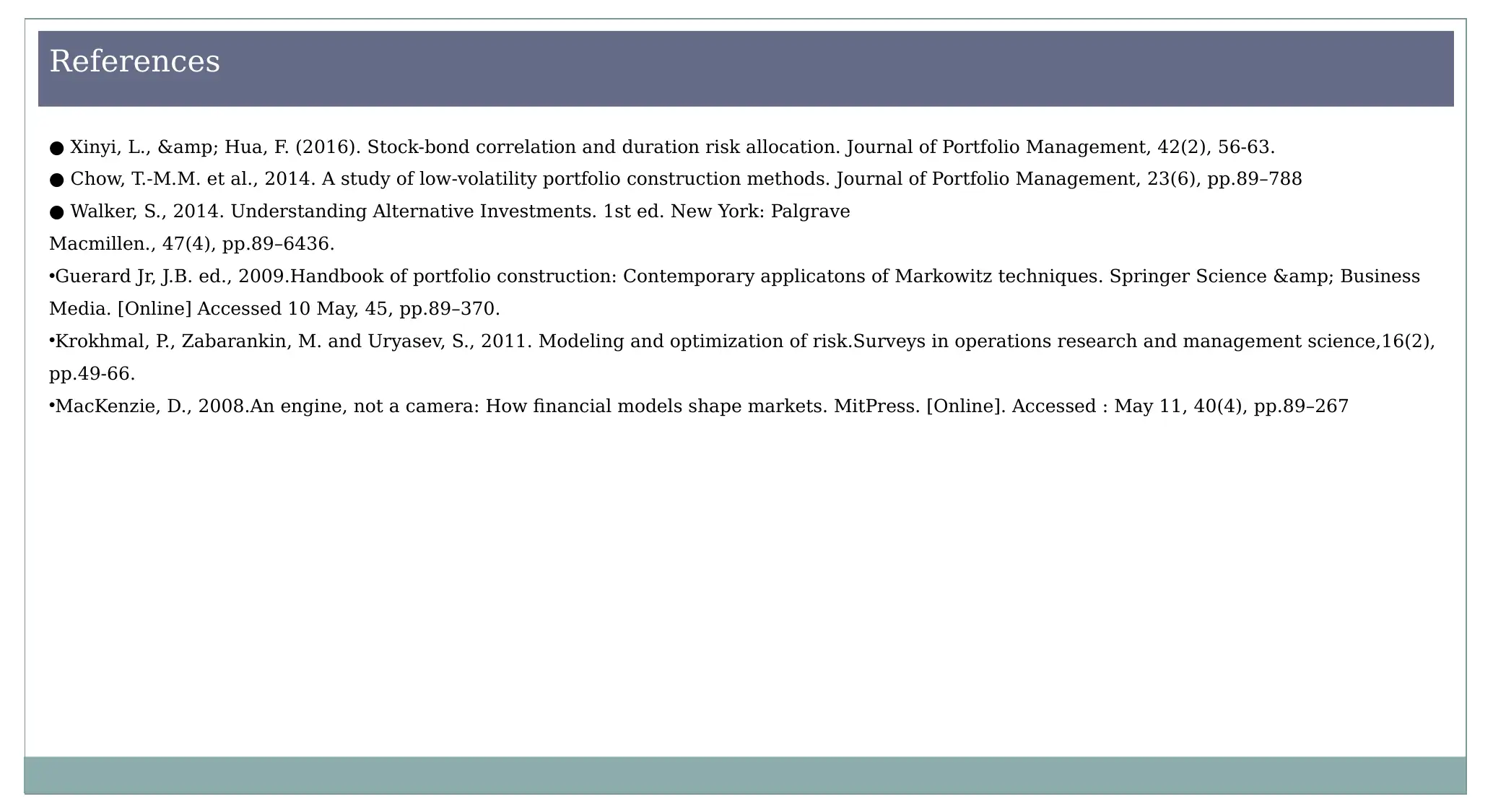
● Xinyi, L., & Hua, F. (2016). Stock-bond correlation and duration risk allocation. Journal of Portfolio Management, 42(2), 56-63.
● Chow, T.-M.M. et al., 2014. A study of low-volatility portfolio construction methods. Journal of Portfolio Management, 23(6), pp.89–788
● Walker, S., 2014. Understanding Alternative Investments. 1st ed. New York: Palgrave
Macmillen., 47(4), pp.89–6436.
•Guerard Jr, J.B. ed., 2009.Handbook of portfolio construction: Contemporary applicatons of Markowitz techniques. Springer Science & Business
Media. [Online] Accessed 10 May, 45, pp.89–370.
•Krokhmal, P., Zabarankin, M. and Uryasev, S., 2011. Modeling and optimization of risk.Surveys in operations research and management science,16(2),
pp.49-66.
•MacKenzie, D., 2008.An engine, not a camera: How financial models shape markets. MitPress. [Online]. Accessed : May 11, 40(4), pp.89–267
ReferencesReferences
● Chow, T.-M.M. et al., 2014. A study of low-volatility portfolio construction methods. Journal of Portfolio Management, 23(6), pp.89–788
● Walker, S., 2014. Understanding Alternative Investments. 1st ed. New York: Palgrave
Macmillen., 47(4), pp.89–6436.
•Guerard Jr, J.B. ed., 2009.Handbook of portfolio construction: Contemporary applicatons of Markowitz techniques. Springer Science & Business
Media. [Online] Accessed 10 May, 45, pp.89–370.
•Krokhmal, P., Zabarankin, M. and Uryasev, S., 2011. Modeling and optimization of risk.Surveys in operations research and management science,16(2),
pp.49-66.
•MacKenzie, D., 2008.An engine, not a camera: How financial models shape markets. MitPress. [Online]. Accessed : May 11, 40(4), pp.89–267
ReferencesReferences
1 out of 11
Your All-in-One AI-Powered Toolkit for Academic Success.
+13062052269
info@desklib.com
Available 24*7 on WhatsApp / Email
![[object Object]](/_next/static/media/star-bottom.7253800d.svg)
Unlock your academic potential
Copyright © 2020–2025 A2Z Services. All Rights Reserved. Developed and managed by ZUCOL.

